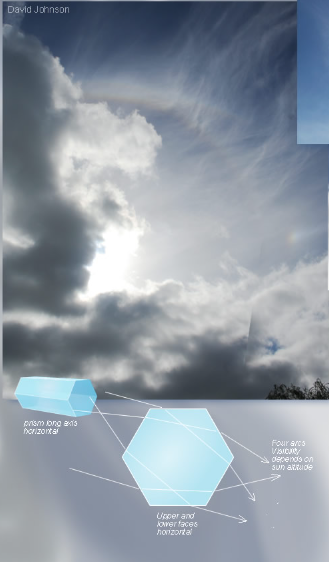Parry arcs
Parry Arcs: A Rare and Spectacular Atmospheric Phenomenon
Parry arcs are a captivating and relatively rare atmospheric optical phenomenon that adds a touch of magic to the sky. These arcs appear as colorful, upper halves of an 'eye' shape, with the lower half being the more commonly observed tangent arc. While they may seem highly improbable, Parry arcs are formed by a specific crystal orientation in ice crystals present in the atmosphere. In this article, we will delve deeper into the fascinating world of Parry arcs and explore the intricate details behind their formation.
Crystal Orientation: The Key to Parry Arcs
To understand how Parry arcs come into existence, we must first examine the crystal orientation required for their formation. For Parry arcs to occur, column-shaped ice crystals need to have their long axes positioned horizontally, along with two prism side faces also being horizontal. This specific alignment of crystals is relatively rare, making Parry arcs a less frequently observed phenomenon.
The Efficiency of Parry Arc Formation
Despite the rarity of the crystal orientation necessary for Parry arcs, these arcs themselves are formed quite efficiently. Even with low concentrations of crystals, Parry arcs manage to manifest prominently in the sky. Rays passing through two side faces that are inclined at a 60° angle to each other create these arcs. There are four possible ways in which these rays can form the arcs, resulting in two arcs above the sun (concave and convex) and two arcs below it.
The Influence of Solar Altitude
The visibility and shape of Parry arcs are heavily influenced by the solar altitude. The arc that is commonly observed is the upper suncave Parry arc, which is visible when the sun is at a higher position in the sky. On the other hand, the upper sunvex arc forms when the sun is lower, adding variety to the types of Parry arcs that can be observed.
Parry Arcs in Action
Witnessing a Parry arc is a truly mesmerizing experience. The vibrant colors and unique shape of these arcs add an ethereal touch to the atmosphere. When conditions are favorable, Parry arcs can be seen in various locations around the world, although they remain relatively rare compared to other atmospheric optical phenomena.
Capturing the Beauty of Parry Arcs
Photographers and sky enthusiasts have been captivated by the beauty of Parry arcs and have managed to capture their splendor through stunning images. These photographs not only showcase the enchanting nature of Parry arcs but also contribute to our understanding of this phenomenon.
The Scientific Significance of Parry Arcs
While Parry arcs are undeniably visually striking, they also hold scientific importance. Studying the conditions necessary for their formation provides valuable insights into the behavior of ice crystals in the atmosphere. Furthermore, understanding the mechanisms behind Parry arcs contributes to our overall knowledge of atmospheric optics and helps unravel the complexities of light interaction with ice crystals.
Discovering the Wonder of Parry Arcs
Parry arcs serve as a reminder of the awe-inspiring beauty that exists within our natural world. Although they may be relatively rare, their occurrence offers a glimpse into the intricate workings of our atmosphere. So, the next time you find yourself gazing at the sky, keep an eye out for these elusive and captivating Parry arcs. You never know when you might witness this remarkable atmospheric phenomenon that paints the heavens with a touch of enchantment.


Parry Arcs over England & Belgium September 21, '08. David Johnson's arc was seen at Newcastle and Jorgen Ravoet's on the Belgian coast at Blankenberge. Images ©David Johnson & Jorgen Ravoet, shown with permission.
The rare Parry arc is the colourful upper half of the 'eye' shape, the lower half is the much more common tangent arc.
Parry arcs result from a seemingly highly improbable crystal orientation. To make them, column crystals must have their long axes horizontal AND two prism side faces also horizontal. We see the arcs because although the orientation is rare, the arcs themselves are formed very efficiently from low concentrations of crystals.
Rays passing through two side faces inclined 60° to each other form the arcs. They can do this in four ways. Two arcs are above the sun, concave and convex to it. Two arcs are below the sun. The visibility and shape of each arc depends on the solar altitude. The arc seen here is the upper suncave Parry arc, the upper sunvex arc forms when the sun is low.
Note: this article has been automatically converted from the old site and may not appear as intended. You can find the original article here.
Reference Atmospheric Optics
If you use any of the definitions, information, or data presented on Atmospheric Optics, please copy the link or reference below to properly credit us as the reference source. Thank you!
-
<a href="https://atoptics.co.uk/blog/parry-arcs-6/">Parry arcs</a>
-
"Parry arcs". Atmospheric Optics. Accessed on December 26, 2024. https://atoptics.co.uk/blog/parry-arcs-6/.
-
"Parry arcs". Atmospheric Optics, https://atoptics.co.uk/blog/parry-arcs-6/. Accessed 26 December, 2024
-
Parry arcs. Atmospheric Optics. Retrieved from https://atoptics.co.uk/blog/parry-arcs-6/.